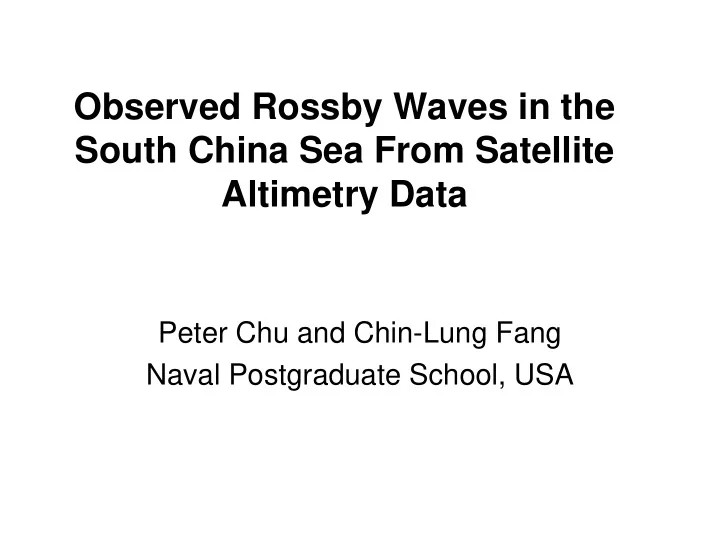

Observed Rossby Waves in the South China Sea From Satellite Altimetry Data Peter Chu and Chin-Lung Fang Naval Postgraduate School, USA
South China Sea
Monsoon Winds (from QuikScat Data)
T/P (a) crossover points and (b) tracks in the SCS.
Modular Ocean Data Assimilation System (MODAS) (Fox et al. 2002) • MODAS is a modular toolkit for estimating present and future conditions in the oceans. It presently consists of over 100 individual programs • MODAS is established on the base of optimal interpolation (OI)
MODAS • To acquire and quality-control input data of various types (including satellite remote sensed information) • To use satellite data to refine climatological temperature and salinity in the oceans • To merge in situ measurements with a "first guess" field to produce a "best guess" of the present conditions in the ocean • To provide gridded SSH, T, S, fields
U.S. Navy’s MODAS System for Satellite Data Assimilation
Temporally Varying Assimilated T/P SSH Data Using MODAS h(t, x, y)
Fourier Series ∑ = ω ω + ω ω h x y t ( , , ) [ ( , , )cos a x y t b x y ( , , )sin t ] ω Hilbert Transform ∑ = ω ω − ω ω h x y t ( , , ) [ ( , , b x y )cos t a x y ( , , )sin t ] t ω Complex Data = + ≡ − H x y t ( , , ) h x y t ( , , ) ih x y t ( , , ), i 1 t
Complex Empirical Orthogonal Function (CEOF) Analysis = ∑ * H x y t ( , , ) PC ( ) t s ( , ) x y n n n = ∑ PC ( ) t H x y t s ( , , ) ( , ) x y n n x y ,
Variances of the First Five Leading CEOFs CEOF Variance (%) Cumulative Variance (%) 1 42.25 42.25 2 16.49 58.74 3 8.84 67.58 4 7.87 75.39 5 5.44 80.83
CEOF1- Seasonal Variability (1993-99)
CEOF1 (42.25% ) • (1) Annual frequency. • (2) Larger seasonal variability in the northern SCS than in the southern SCS with strongest signal occurring from Luzon Strait to the central SCS at 15 o N (upper left panel). • (3) Coincidence of minimum value of a 1( t ) and 1997- 1998 El Nino event • (4) Weak SCS seasonal variability to the El Nino event.
CEOF2-Rossby Wave Signal (1993-99)
CEOF2 (16.49%) • Interannual and Intraseasonal frequencies. • Evident interannual variability occurring from April 1994 to December 1995, and from April 1996 to December 1998. • Intraseasonal frequency occurring during the rest of periods. • Rossby waves weakens as they are propagated into the SCS. • Coincidence of maximum value of a 2( t ) and 1997-1998 El Nino event • connection between the strong Rossby wave signal to the El Nino event.
SSH Anomaly (Interpolated using MODAS) • Westward propagation in northern SCS (15 o , 17 o , 20 o N) • No apparent westward propagation at 10 o N • Day-0: January 1, 1993 Day-2555: December 31, 1999.
Conclusions • (1) The seasonal signal accounts for 42.25% of the total variability. • (2) The seasonal variability is larger in the northern SCS than in the southern SCS. • (3) Weak SCS seasonal variability may be connected to the El Nino event. • (4) The interannual and intraseasonal variability accounts for 16.49% of the total variability. • (5) The strong Rossby wave signal may be connected to the El Nino event. • (6) The westward propagating Rossby wave signals are detected only in the northern SCS (north of 15oN) not in the southern SCS (south of 15oN). The phase speed is estimated by 0.05 – 0.08 m/s.
Recommend
More recommend